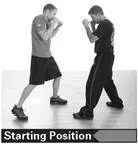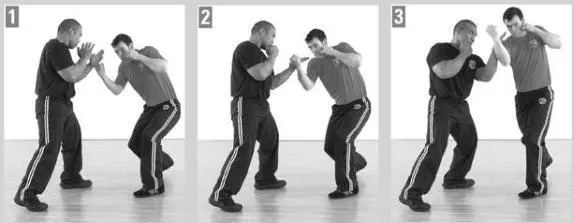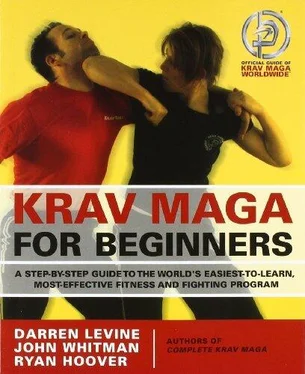KEY POINTS
• make a defense similar to 360, except that you make a fist and defend with the back of your hand and arm, rather than the blade
• put your weight and power behind the defense
• defend at the wrist so that the attack does not hook around your defense
• tuck your chin and raise your shoulder
COMMONLY ASKED QUESTIONS
Can’t I just do a 360° defense?
Yes. The advantage of a 360 is that it’s faster. However, the 360° defense assumes you are in a poor state of readiness, with hands down or at least unprepared. This defense assumes that you know you’re in a fight, with your hands up in a fighting position with the pinky side of your hand forward. From this position, it may take a little longer to rotate the blade of your arm around, so the Hook Punch Defense may be preferred.
What happens if I don’t defend at the wrist?
Hook punches are designed to “hook” around a defense. If you defend farther up the arm, toward the attacker’s elbow, you’re letting the fist come around your defense and possibly hit you.
What if the hook punch is to the body? Follow the same principles, but you would make a defense similar to 360° Defense #4.
Training Tips:Because hook punches are powerful, be sure your defense is very strong and that you put weight behind it.
Defense against Hook Punch (Covering)
ATTACK→ The attacker throws a right hook punch to the head or body.
IMMEDIATE DANGER→ Being struck. The primary danger is being hit.
SECONDARY DANGERS→ Disorientation, balance. If the initial attack is not blocked, the defender may find himself disoriented by the first strike, or have the wind knocked out of him, or be knocked off balance, and therefore open to additional strikes.
SOLUTION→ Hook Punch Defense (Covering)
1As the attack comes around to head, bring your arm up, elbow bent, so that your forearm and upper arm both cover the side of your head. Your hand should be back far enough so that your forearm/biceps makes the defense, NOT the hand. Have your hand in a fist. Keep your chin down and your arm pressed against the side of your head. Your elbow should point forward.


INITIAL COUNTERATTACK→ Straight Punch (page 71), Front Kick (page 92), or Hook Punch (page 85). It’s not usually possible to deliver a simultaneous counterattack, since you’re absorbing more of the punch. However, as soon as possible, deliver a counterattack such as a front kick to the groin, straight punch (often with the arm that just defended), or a hook punch with the free hand.
NEUTRALIZING THE ATTACKER→ After the initial counterstrike, the defender should continue to strike to the body and face. Students must focus on rendering the attacker unwilling or unable to continue the assault.
KEY POINTS
• bring your arm up to cover the side of the head with both the forearm and the upper arm
• your hand should be back far enough so that your forearm, not your hand, is defending
• tuck your chin and keep your arm pressed to the side of your head, elbow forward
COMMONLY ASKED QUESTIONS
When I defend, I feel my head getting jarred. What’s wrong?
Keep your forearm pressed against your head more. If there is space between your arm and your head, when the hook punch hits your arm, it will bang into your head and give you a jolt. Note that this defense does absorb the strike, so you may feel some impact. However, the power should be distributed along your forearm and upper arm, reducing its effect.
Why does Krav Maga prefer the extended defense instead of this one?
The extended defense allows you to defend farther from your body, which is important in a street fight when the attacker might be holding a knife you do not see. If you use the covering defense in that case, the knife would stab into the arm, and possibly into the head. In addition, the covering defense exposes the ribs, leaving you open to body shots.
If the covering defense has these weaknesses, why teach it?
Sometimes during a fight, the attacker comes very close and throws fast hook punches. There’s often no time to send the arm out and away from the body. If there were time, we’d prefer the extended defense in all cases.
Defense against Uppercut Punch
This is a redirecting defense. Although the technique is somewhat different from the Inside Defense, the redirecting principles are the same.
ATTACK→ The attacker throws a right uppercut punch to the head or body.
IMMEDIATE DANGER→ Being struck. The primary danger is being hit.
SECONDARY DANGERS→ Disorientation, balance. If the initial attack is not blocked, the defender may find himself disoriented by the first strike, or have the wind knocked out of him, or be knocked off balance, and therefore open to additional strikes.
SOLUTION→ Uppercut Punch Defense
1-3As the uppercut punch rises, bring your left forearm inward and upward, redirecting the uppercut punch up and slightly to the side. The side of your arm should touch the side of the attacker’s arm. As you defend, rotate your wrist—this rotation will help redirect the punch farther from your body. Keep your hand up! Your elbow should lead the motion. At the same time, make a body defense by “blading” your body to the dead side. Do NOT follow the punch up too high—keep your hands in the ready position. Defend just enough to avoid the punch.

Note the similarities to the Inside Defense against a Straight Punch Low (page 108). The mechanics are very similar, except that in most cases the uppercut punch rises, so we follow that path. Sometimes an attacker can throw an uppercut punch that travels forward (such as an uppercut punch to the body); in that case, this defense looks and feels even more like the Inside Defense against a Straight Punch Low.
INITIAL COUNTERATTACK→ Straight Punch (page 71) or Hook Punch (page 85). As you make the defense, counterattack immediately with the other hand, throwing a straight punch or a hook punch. Other counterattacks are also possible, but these will usually feel the strongest.
NEUTRALIZING THE ATTACKER→ After the initial counterstrike, the defender should continue to strike to the body and face. Students must focus on rendering the attacker unwilling or unable to continue the assault.
KEY POINTS
• redirect the punch by guiding it upward and away
• lead with your elbow; keep your hand up
• the principles are very similar to the Inside Defense against Straight Punch Low
• blade your body to make a body defense
• do not “follow” the punching arm up too high; defend just enough to avoid the punch
Читать дальше















